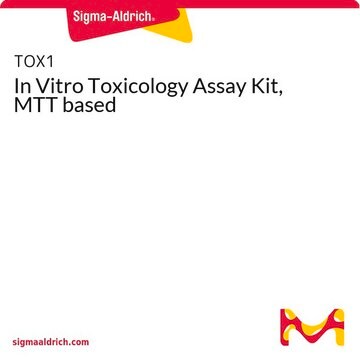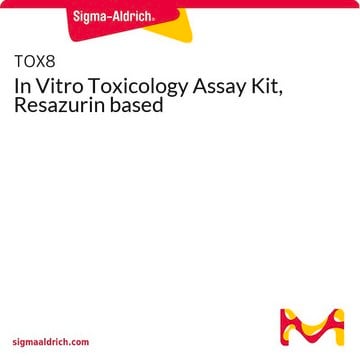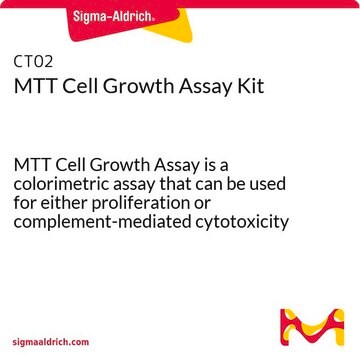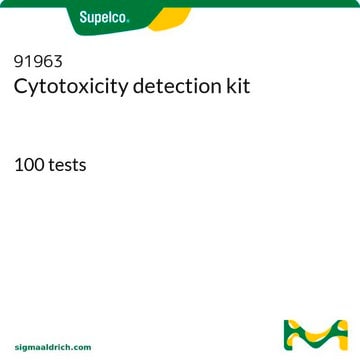The recommendation to use tissue culture grade water is primarily to ensure there are no trace elements or contaminants present that could impact the metabolic health of the cells being screened. The incubation period is relatively brief and cells are not likely to be negatively impacted. The use of sterile filtered or autoclaved water will not negatively impact the functionality of the kit. It would be up to the end user to deviate from the recommended protocol.
Wichtige Dokumente
TOX7
In-Vitro-Toxikologie-Assay-Kit, Lactatdehydrogenase-basiert
Synonym(e):
LDH cytotoxicity assay
Größe auswählen
865,00 €
Versandbereit am07. April 2025Details
Größe auswählen
About This Item
865,00 €
Versandbereit am07. April 2025Details
Empfohlene Produkte
Form
liquid
Verwendung
1 kit sufficient for 500 tests
Verpackung
pkg of 1 kit
Lagerbedingungen
dry at room temperature
Methode(n)
protein quantification: suitable
λmax
490 nm
Anwendung(en)
cell analysis
detection
Nachweisverfahren
colorimetric
Lagertemp.
−20°C
Allgemeine Beschreibung
Anwendung
- zum Nachweis der Freisetzung von Lactatdehydrogenase in Endothelzellen aus humanen Nabelschnurvenen (HUVECs) und humanen Herzmuskelzellen (HCMs) im Lactatdehydrogenase(LDH)-Assay[1]
- zur Bestimmung der Aktivität beim Austritt von Lactatdehydrogenase aus MDA-MB-231-Zellen[2]
- zur Untersuchung der LDH-Aktivität in RAW-264.7-Zellen[3], in LDH-Zytotoxizitäts-Assays für humane Zelllinien[4]
- zur spektralphotometrischen Messung lebensfähiger Zellen Die Extinktion des umgewandelten Farbstoffs wird bei einer Wellenlänge von 490 nm gemessen.
Biochem./physiol. Wirkung
.
H-Sätze
P-Sätze
Gefahreneinstufungen
Aquatic Chronic 3
Lagerklassenschlüssel
10 - Combustible liquids
Hier finden Sie alle aktuellen Versionen:
Analysenzertifikate (COA)
Die passende Version wird nicht angezeigt?
Wenn Sie eine bestimmte Version benötigen, können Sie anhand der Lot- oder Chargennummer nach einem spezifischen Zertifikat suchen.
Besitzen Sie dieses Produkt bereits?
In der Dokumentenbibliothek finden Sie die Dokumentation zu den Produkten, die Sie kürzlich erworben haben.
Kunden haben sich ebenfalls angesehen
Artikel
Quality control guidelines to maintain high quality authenticated and contamination-free cell cultures. Free ECACC handbook download.
Zellbasierte Assays für Zellproliferation (BrdU, MTT, WST1), Zellviabilität und Zytotoxizitätsversuche für Anwendungen in der Krebs- und Stammzellforschung und in den Neurowissenschaften.
Cell based assays for cell proliferation (BrdU, MTT, WST1), cell viability and cytotoxicity experiments for applications in cancer, neuroscience and stem cell research.
-
in the TOX7, it describes that the 25 ml of 1× LDH Assay Cofactor Preparation by adding 25 ml of tissue culture grade water to the bottle of lyophilized cofactors (Catalog Number L2527). Can I use Sterile Filtered and Autoclaved Sterile water to prepare?
1 Antwort-
Hilfreich?
-
-
How do i estimate the LDH release? what is the equation?
1 Antwort-
The TOX7 kit is utilized primarily as a cell viability assay based upon cellular metabolic activity. LDH reduces NAD+ which is then converted to a tetrazolium dye. This dye is then solubilized and read at 490nm. The resulting absorbance in associated with cell density or viability.
Please refer to the Product Information Sheet for more information regarding this product: https://www.sigmaaldrich.com/deepweb/assets/sigmaaldrich/product/documents/336/418/tox7bul.pdf
Hilfreich?
-
-
Can TOX7, In Vitro Toxicology Assay kit be used to quantitate the amount of LDH in my samples?
1 Antwort-
This assay kit was designed as a semi-quantitative assay for LDH. The change in the OD between the treated samples and control samples is to be compared and is generally reported as a fold increase/decrease from the control. The kit does not contain a LDH standard. Product L3916 can be used as an LDH standard for this assay. The detection range (LDH units/ml) for the kit has not been established.
Hilfreich?
-
-
The TOX7 dye solution has a precipitate present. Can I still use it?
1 Antwort-
Product No. L2277 LDH Assay Dye Solution is a saturated solution and some precipitation may appear upon thawing. The product will partially re-solubilize when warmed to 37°C and the resulting solution can be decanted away from any remaining precipitate. Precipitated dye added to reactions, or removed from the solution will not affect the performance or results obtained from this kit.
Hilfreich?
-
-
Can you use tissue explants in product TOX7, In Vitro Toxicology Assay Kit, Lactic Dehydrogenase based?
1 Antwort-
Unfortunately, we have not tested product TOX7, In Vitro Toxicology Assay Kit, on tissue samples. If the tissue is minced well and can be lysed completely with the lysis buffer for the cells, it may work to determine cell biomass. The following paper modified the assay for use with explants.Benyo, D.F., et al., "Hypoxia Stimulates Cytokine Production by Villous Explants from the Human Placenta", The Journal of Clinical Endocrinology & Metabolism 82(5), 1582-1588 (1997).Assessment of explant viability was routinely monitored by measuring the release of LDH into medium relative to a 1% Triton X-100 (Sigma)-lysed positive control. The assay employed a modification of the TOX7 viability kit supplied by Sigma-Aldrich and entailed adding a 20-fold volume excess of assay mixture (160 mL) to the medium sample tested (8 mL). The assay mixture consisted of equal volumes of substrate (lactate), enzyme (diaphorase), and dye (nitro blue tetrazolium) solutions, and the reaction was allowed to proceed for 20 min in a microtiter plate before the addition of 0.1 vol 1N HCl. Color change was quantified by reading the absorbance at 490 nm, and the percent cell death calculated.
Hilfreich?
-
-
Will Triton X100 interfere with the TOX7 In Vitro Toxicology Kit assay?
1 Antwort-
Triton X100 will not interfere with TOX7 assay.
Hilfreich?
-
-
What is the minimum number of cells to use in the LDH assay, Product TOX7, In Vitro Toxicology Assay Kit?
1 Antwort-
Using Product TOX7, In Vitro Toxicology Assay Kit, the minimum cell number for best response is 2 x 104.
Hilfreich?
-
-
What is the Department of Transportation shipping information for this product?
1 Antwort-
Transportation information can be found in Section 14 of the product's (M)SDS.To access the shipping information for this material, use the link on the product detail page for the product.
Hilfreich?
-
-
I am using a protease inhibitor cocktail in the cell culture media. Will this interfere with the TOX7 In Vitro Toxicology assay?
1 Antwort-
The protease inhibitor cocktails do not interfere with LDH activity. Media from cells cultured with protease inhibitors can be used in this assay.
Hilfreich?
-
-
I'm using the TOX7 In Vitro Toxicology Assay Kit. I do not have a 690 nm filter to use for a reference/background. What can I use?
1 Antwort-
The reference wavelength needs to be greater than the absorbance spectra of the assay. The greater the difference between the assay wavelength and the reference wavelength, the better. A reference wavelength of 590 nm or greater can be used with the substrate for this assay. If a reference wavelength is not available, the assay will work. The use of the reference wavelength increases the signal to noise ratio to give a better assay range.
Hilfreich?
-
Aktive Filter
Unser Team von Wissenschaftlern verfügt über Erfahrung in allen Forschungsbereichen einschließlich Life Science, Materialwissenschaften, chemischer Synthese, Chromatographie, Analytik und vielen mehr..
Setzen Sie sich mit dem technischen Dienst in Verbindung.












